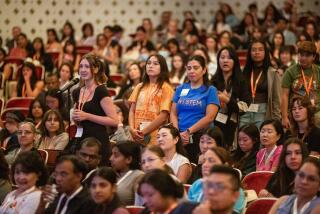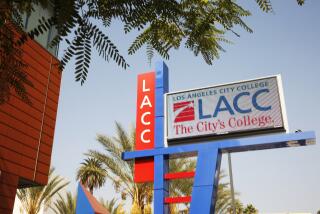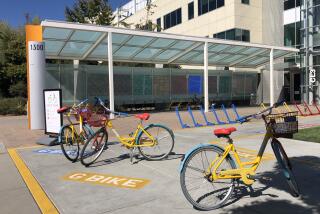At Small Colleges : Scientists: A Crisis in the Making
- Share via
By any standard, Corwin Hansch is a productive scientist.
He and his colleagues have developed several thousand complex equations that have been used by drug and chemical companies to design cancer drugs, antibiotics, insecticides, plant growth hormones, pesticides and blood pressure regulators.
For such work, Hansch is cited in the scientific literature even more often than seven of the 10 most-cited Nobel Laureates in chemistry. From 1965 to 1978, a period during which more than a million scientists published research papers, he was one of the 300 most-cited authors. And since 1979, his papers in scientific journals have been cited an average of 779 times per year.
None of that would be surprising except that Hansch is not a faculty member at Caltech, UCLA or MIT.
Liberal Arts College
Instead, he is Carnegie professor of chemistry at Pomona College in Claremont, a liberal arts school with only 1,325 students, all undergraduates.
Hansch also is a part of a little-noticed crisis in science education in the nation’s small colleges, which employ nearly 70% of all science teachers in the country.
Science education in such small colleges is coming under increasing attack for “serious deficiencies,” including having many faculty members who are uninspired and who teach material that is out of date. Such criticism comes at a time when fewer and fewer students--at universities as well as at small colleges--are studying science. At the same time, the smaller colleges are having increasing trouble recruiting faculty.
Such problems have all but obscured the fact that science teachers at smaller colleges as a group long have published more papers per research dollar than their better-known counterparts in the universities.
Crunch in Funding
But now, some fear, all that may change because of a forthcoming crunch in federal funding for research and science education. And despite a recent National Science Foundation call for Washington to more than double its funding for undergraduate science education--to more than $100 million by 1989--scientists like Hansch foresee severe problems. One major reason is the steadily rising cost of scientific instruments, which is expected to grow by 50% by the end of this decade.
Such a financial crunch may well prompt the chemical industry to pour large sums into the small colleges, thereby positioning itself to exert a strong influence on undergraduate science education throughout the country--as it already has done at larger universities.
What makes Hansch’s achievements all the more remarkable is that he must spend at least twice as much time teaching as scientists at larger, research-oriented institutions. And he has no graduate students to grade the papers for those courses, no graduate students to teach the laboratory sections of the courses and no graduate students to carry out his research and to co-author papers.
“Hansch is a hallmark individual because of the example he sets for researchers at other undergraduate institutions,” said chemist Michael Doyle of Trinity University.
Hansch recently became the first recipient of the American Chemical Society Award for Research at Undergraduate Institutions, an award created to draw attention to the fact that there are dozens of scientists at undergraduate schools with credentials as impressive as Hansch’s.
But a general lack of recognition is only one problem facing scientists at small colleges.
Increasingly, they are being criticized for the quality of their teaching and for their failure to do sufficient research. Some of the harshest criticism came in a recent report prepared for the influential National Science Foundation that said undergraduate education in science, mathematics and engineering contains “serious deficiencies.”
‘Tedious and Dull’
In particular, the report said, laboratory instruction is often “uninspired, tedious and dull,” and that faculty, courses and curricula are frequently out of date. Many of these problems arise, it concluded, because a significant proportion of the science faculty at the nation’s 1,500 undergraduate institutions are not carrying out research.
“Science is not a good spectator sport,” according to chemist Jerry Mohrig of Carleton College. “You don’t remain a good teacher unless you are professionally active.”
But such increasing demands for more research are making it harder for the smaller colleges to recruit faculty, especially in disciplines like physics, according to Alvin Hudson, chairman of the physics department at Occidental College. “Given the choice between a university and a college, a physicist is going to go to the larger school because he knows the opportunities for conducting research will be much greater.
Ironically, what has attracted science students to the smaller institutions is often what can make life difficult for the science teachers.
The precise reasons why students choose undergraduate institutions are widely varied, of course. Some may find the ambiance of a small college more inviting. But many say they were drawn to such colleges because of the greater interaction with faculty that is often impossible at universities.
“The value of my undergraduate program (at Macalester College) was the individual attention that the professors were able to provide,” said astronomer Richard Binzel of the University of Texas. “The emphasis of the professors is on teaching, not research, and hence they are able to spend more time with students.”
Such emphasis on teaching and intimate contact with students, however, cuts sharply into research time.
“I teach about 12 to 15 hours a week--typically one lecture and two labs, plus a seminar for advanced students,” the 67-year-old Hansch said in a recent interview. “A chemist at Caltech may teach maybe three hours a week. I also grade all my own papers for as many as 60 students.”
Study of Molecules
In his research, Hansch and his colleagues have developed a series of equations that relate observable biological effects to specific, measurable properties of molecules. These equations are formally known as “quantitative structure-activity relationships” (QSARs), but they are more often known as Hansch equations.
“We are simply trying to work out some of the rules for understanding the relationship between chemical structure and biological activity,” he explained with characteristic modesty.
In practice, the first step in using the Hansch equations is determining the biological effects of a series of closely related compounds. The equation then reveals how the structure of the molecule should be varied to obtain the maximum biological effect.
Hansch cites the example of a European friend whose company had developed “an exciting new heart drug of low toxicity. At the clinic, however, patients had a strange reaction--they were seeing bright illuminations.”
Nerves Involved
After some investigation, it was clear that the bright illumination was occurring because of the drug’s action on the central nervous system. Using the Hansch equation, the company was able to make a minor adjustment in the structure of the drug to reduce its effect on the central nervous system without changing its effects on the heart.
Hansch is fortunate in that the research subject he chose requires a minimal amount of actual laboratory research. He and his students--and his technicians and post-doctoral fellows--have synthesized many classes of chemicals and measured their properties and biological effects, to be sure. By far the greatest amount of Hansch’s work, however, has involved data from the literature.
“We’ve used millions and millions of dollars worth of data collected at other places,” Hansch said. “We simply bring it back from the library, crank it through the computer and interpret it.”
Using data from the literature, Hansch has published more than 250 papers. Since his first paper on QSARs was published in 1961, Hansch has had 43 different undergraduate co-authors. Ten of those appeared as co-authors twice, and one three times.
Most Publish Less
Most researchers at undergraduate institutions--indeed, most scientists anywhere--are considerably less prolific than Hansch. A recent study prepared by a consortium of 48 small colleges that have banded together to study the future of science at liberal arts institutions showed that their science faculty had published an average of 0.6 journal articles per person per year. And one in every three of those articles was co-authored by an undergraduate.
Another study has shown that the average publication rate at major research institutions is 3.2 papers per person per year. There are no figures for the percentage of undergraduate co-authors at such institutions, but the number is generally believed to be quite small.
One reason that undergraduates are not co-authors of more papers is that they do not stay very long--a source of great frustration for many researchers.
Training Involved
“You are taking a totally untrained person and spending an enormous amount of time to train them,” Doyle said. “It usually takes at least a year and $3,000 before they can begin to contribute to your program. And then, just when they get most productive, they go off and do something else. They go to graduate school or to medical school, or they just go.”
In addition, the pace of research by undergraduates is “inherently slower,” Mohrig said, because “you have to let them make some mistakes or they don’t learn anything.”
“The students also carry a fairly heavy load,” Hansch said, “so only a few can find time to do research during the school year.” Hansch, like many other faculty members, typically has only one student working during the school year, but may have as many as seven during the summer.
In some disciplines, such as physics, it is almost impossible for undergraduates to do research, said Occidental’s Hudson. “They can’t read the journals, they can’t do the necessary math. Even in graduate school, physics students don’t start doing research right away because they don’t have the background.”
Despite all this, Hudson added, “it is possible for undergraduates to do physics research, but the problems are really difficult.” Nonetheless, undergraduate research is important, Mohrig said, because “it is a superb teaching tool.”
The students who do research, furthermore, usually have little trouble getting into the graduate school or medical school of their choice.
Money is another sore point with science teachers at small colleges. Most faculty at such schools receive a smaller salary than their peers at larger institutions. The maximum is about $60,000 a year, which is what Hansch was making before he went to half-time teaching this year as a prelude to retirement. Scientists at larger schools can make more than $100,000 per year.
Contrary to expectations, however, scientists at undergraduate institutions produce more published papers per research dollar, according to Mohrig, who is president of the Council on Undergraduate Research, a “support group” for chemists at small colleges.
That is not surprising, Mohrig said, “because we’re not really feeding people”--that is, they are not providing living expenses year-round, as is the case with many graduate students.
Money has never been a driving motivation for Hansch, however.
The Pomona chemist was born in Kenmare, N.D., in 1918. He went to college at the University of Illinois and did his graduate work at New York University.
Atomic Bomb Research
Before he joined Pomona College, Hansch worked on the Manhattan Project, which developed the atomic bomb and, for a short period, Du Pont Co.
“I came to Pomona with the idea that it was a place to get started,” he said. “I found out that it was a very fine place to stay.”
At the time, the school was about the same size as it is now, but the chemistry department had “virtually no equipment.” His first grant, $2,400, was bigger than the department budget.
Even now, Hansch must operate with limited funds--typically about $100,000 a year. Most of that normally goes to support technicians and post-doctoral researchers--rarities among scientists at small colleges.
Most scientists at undergraduate institutions must make do with even less money than Hansch.
Funding for research at small colleges has been growing, but it started from a low base and the growth has been relatively slow, according to Trinity’s Doyle, founding president of the Council on Undergraduate Research.
In 1981, the National Science Foundation awarded $27 million to undergraduate institutions out of a total budget of $800 million. By 1987, that figure is scheduled to be $42 million, Doyle said.
Federal Money Sought
The new foundation report urges the government to provide at least $100 million for undergraduate education by 1989. But it also concluded that small colleges must turn elsewhere for funding, such as to industry.
And some progress is already being made in this area.
When several large chemical companies in the early 1970s formed the Council on Chemical Research to promote interactions between academia and industry, principally through funding of research, they ignored the undergraduate schools, Doyle recalled.
But now the council is considering establishing similar links to the Council on Undergraduate Research.
Here again, Hansch is proving to be an exception to the rule. He already has lots of contacts with industry because his research has proved so vital to industry.
Hansch is not sure he would advise a young Ph.D. to seek employment at a small college because “everything is loaded against you.” But he has no personal regrets.
“Because you are somewhat out of the mainstream, you can do any damn thing you want to,” Hansch said. “I probably would never have had the long period of time necessary to develop QSAR if I had been at a larger school. I’ve really enjoyed my career here.”
Still, he said wistfully, “it’s a more lonely sort of existence than it might have been elsewhere.”






